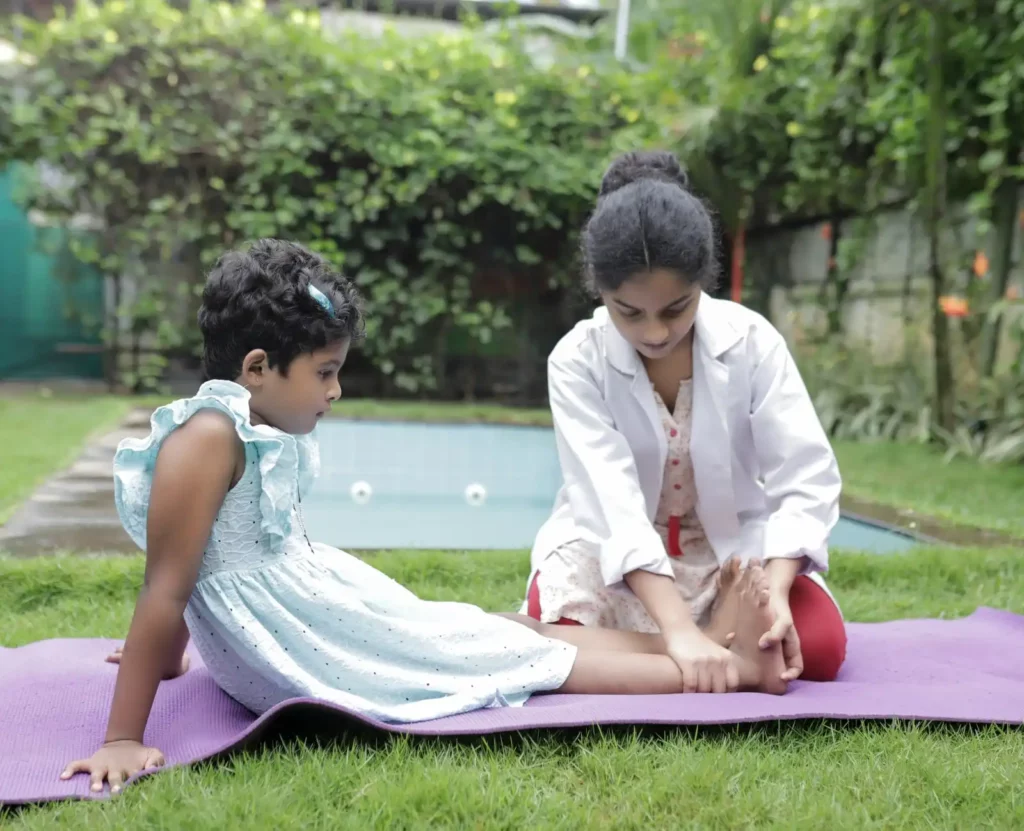
Written by
Anju Francis, MPT in pediatrics
Physiotherapist
Parents are always excited about their child’s development. They closely monitor their child in every possible manner and get more tense and worried if their child shows any unusual movement or delay in their development. Let’s check how parents can involve and help in the development of their child at home.
Understanding the Importance of Physiotherapy for Children
Pediatric physiotherapy is a therapeutic practice that focuses on providing rehabilitative services
to children from birth through childhood and adolescence. Poor balance and coordination,
frequent falls, poor posture, and muscular soreness are all common issues that necessitate seeing a pediatric physiotherapist. Babies who have difficulty turning their heads, rolling, sitting, crawling, or walking can benefit from physiotherapy as well. To properly treat children, a paediatric physiotherapist employs techniques such as strengthening, exercise, stretching, movement training, intense therapy programmes, motor learning and play, and teaching. It is critical that parents instruct their children at home in order for them to progress more quickly and achieve greater achievements.

Safe and supportive environment
Babies and young children learn about the world through their relationships and experiences. A safe and supportive environment is a setting in which all children can feel socially, emotionally and physically safe and valued. A supportive environment is important for home programme. What can parents do? A safe and supportive environment can be set up by paying attention to the following
● Make sure that child is comfortable and happy within the home setting
● Always prefer child’s comfortable and active period of time
● Provide things that the child love and include them in the sessions
● Can provide play as a mode of exercise. This will encourage the child to do exercise
without feeling bored
● Try to ensure that the environment is not overwhelming to their senses● Make sure that the physical environment gives older babies and children opportunities for
autonomy and independence, with a range of areas that are safe to explore.
● Organize the day around familiar routines, but make sure the structure is flexible enough
to be adapted to children’s natural preferences and rhythms.
Clearing Space for Physical Activities
Children enjoy exploring their surroundings and enjoy themselves when they have ample space to play. It is also true in terms of exercise. In order to reach a milestone, children will always practice their movements multiple times. Making a clear, hurdle-free space will thus assist the child in achieving new results. Parents should ensure that their children are safe and that their surroundings are free.
Removing Hazards and Obstacles
Injury during the home programme is a significant and serious problem. It could be due to carelessness or, in rare cases, barriers in their environment. Children move quickly and will be immersed in their world. As a result, hazardous things such as fire extinguishers, electrical equipment, and thermal agents such as hot water or hot food items should be kept out of their reach.
Providing Proper Equipment and Accessories
Therapists utilize a variety of equipment and tools during therapy sessions, and it may be impossible for parents to purchase everything at the same time. Parents can create these devices at home with the help of a therapist. For example balster and wedges can be replaced by cushions or pillows. Parents should work with the therapist to make changes so that the child is comfortable while utilizing the tools.
Establishing Consistency and Routine
Therapists assist parents in carrying out the programme and ensuring that it is realistic and practical. The programme must fulfill the needs of the family while also achieving the intended goals. Therapists should offer assistance to the family by establishing contact with the parents on a frequent basis, assisting parents in identifying areas for growth, seeing the parent conduct the tasks and providing relevant feedback, providing positive feedback so that the parents confidence improves, and displaying empathy and concern for the family are all examples of support.
Setting Regular Physiotherapy Sessions
It is well-accepted that children with disabilities require regular practice with new tasks. It happens by repeating a task numerous times in different situations. As a result, therapists have begun to prescribe home programmes to practice activities learned during therapy sessions while at home. Home programmes are thus a therapeutic technique in which therapists and the family collaborate to construct a specific set of activities for the kid that focus on pre-established goals.The activities are carried out at home by the family. The sessions should be done on a regular basis or according to the therapists recommendations, and the frequency of exercise ought to be taken into account.
Creating a Structured Exercise Schedule
After determining a convenient time for both the parent and the child, the activity should be designed so that it never exhausts the child. Always begin with gentle exercise and ensure that it does not make them stressed. Make certain that the child is actively involved. Parents must take care of their own health and avoid undesirable and harmful postures. Inform your therapist if you experience any discomfort or health issues during or after any activity.
Maintaining Open Communication with the Physiotherapist
Communication between parents and therapists is an important aspect of the home programme inchild physiotherapy. The kids needs and improvement are important aspects of the home programme, and this is monitored by the therapists through the child’s parents. The parent can implement changes and corrections to the home programme. The childs response to the exercise will differ in the clinical and home settings, so parents should be aware of this and inform their therapist. Parents play a significant role in it because they are with their children majority of the time.
Encouraging Active Engagement
Every child will be more playful and free when they play whatever they like and love. They hesitate to do activities that are compelled by parents or others. Try to include things that the child loves and engage them in sessions appropriately so that it helps in achieving therapy goals.
Making Physiotherapy Fun and Interactive
Making physical therapy fun for kids can be achieved through various strategies depending on their age and needs. This helps in increasing consistency, meaning, and enjoyment for better therapeutic outcomes. So what are these strategies? lets look.
● Perform their exercise in fun environment
Although it may not always be possible or practical, practicing your kid’s physical therapy exercises in an atmosphere or place that your child enjoys can help your childs physical therapy process better. Even if its as basic as doing their physical therapy in their favorite area in the house (such as their own bedroom), it can make the process more fun for the youngster.
● Let them have a choice in their activity
When it comes to doing activities, it turns out that children are more willing to engage when they believe they have a choice in what needs to be done. Giving children an active role increases their capacity to not just participate but also enjoy the process. For instance, allow your child to dress up as their favorite superhero or princess before beginning physical therapy (if the child is already comfortable with their therapy exercises, you could even ask the child to demonstrate how the superhero, princess, etc. would complete the activity).
● Use toys when possible
Whether its a stuffed animal, a toy car, an action figure, or simply the childs favorite blanket, integrating a meaningful personal object into any exercises or activities can make a significant difference for a child receiving therapy. Its application is practically limitless, and it will almost certainly be as unique to the scenario and therapeutic task as the child himself. For example, allow your youngster to perform their activities with their favorite toy or object at their side.
Providing Motivation and Positive Reinforcement
Always use positive language with the child. It should motivate and assist the youngster to do more. Giving his or her favorite foods after a successful exercise will reinforce them. Give points or chocolate to a youngster every time he or she successfully completes an exercise (Give a reward once a certain number of points have been obtained).
Promoting Healthy Habits and Lifestyle
Parents should take care of the food they purchase. Serve a range of healthy foods instead of junk food. Include fruits and vegetables in your childs diet. As a family, eat meals and snacks together. Eat at the table rather than in front of the TV. Make sure your children drink plenty of water. Limit the intake of sweetened and regular-calorie beverages. Maintain your childs body weight. Overweight of the child can cause problems for both the therapist and the parent during therapy sessions, and it can also have an effect on your childs health. It is critical for the childs
overall well-being that parents ensure that the youngster has an optimal sleep cycle. Make physical activity a part of your everyday routine. Provide swimming, cycling, or any other sport if the child is able to do it.
Collaborating with the Physiotherapist
Seeking Professional Guidance and Advice
Even if you practice the exercises at home, your physiotherapist is still involved in your rehabilitation. You should meet with your physiotherapist on a frequent basis to discuss progress, setbacks, difficulty with the programmes, changes in the child’s condition or pain, flare-ups, and other issues. Youre likely to come across facts on the internet while performing physiotherapy at home that you’ll need to clarify. Staying in touch with your physiotherapist can assist you in finding correct and dependable answers, preventing you from falling down a confusing maze of misinformation and useless cures.
Sharing Observations and Progress with the Physiotherapist
Treatment sessions in physiotherapy are customized to your unique illness, baseline values, home environment, goals, activity level, comorbidities, and general health. That is why you cannot make substantial changes on your own. Always share your observations with your therapist during and after each exercise. If the child exhibits any changes or you notice any progress, keep in touch with the physiotherapist so that the therapist can suggest new activities.
Asking Questions and Addressing Concerns
Although your suggested exercises will be similar to those of others, there will be tiny variances that can have major effects. Small alterations, such as extending your range of motion or adding a kilogramme of weight to your dumbbell, should be fine. Your physiotherapist is the ideal person to advise you on exercise modifications if necessary. So, if you require a modification or progression, avoid going to untrustworthy sources.
FAQ
Ensure a safe and clutter-free space with ample room for movement. Remove any potential hazards and provide supportive equipment like mats or cushions
Engage in exercises that promote flexibility, strength, and coordination, such as stretching, balance exercises, and age-appropriate movements.
Make it fun and engaging! Use games, music, or colorful props to make the exercises enjoyable. Offer praise, rewards, and involve other family members for support.
Yes! You can consult with your child’s physiotherapist for specific home exercise programs, educational videos, or apps that provide guidance and monitoring of progress.

